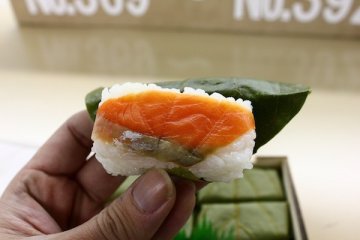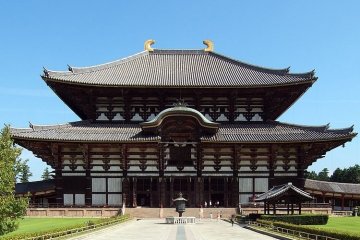
奈良摩登廚房Nico Style
Melky Chen奈良出身的傑尼斯藝人堂本剛也曾探訪的位於奈良町(ならまち)古色古味小巷裡的和食創意料理「摩登廚房Nico Style(和モダンキッチン・にこすたいる)」。

The great Kasuga Shrine (Kasuga Taisha) is located in Nara Park. It was built at the same time as the capital and is dedicated to the deity responsible for protecting the city. The shrine was recognized as a UNESCO World Heritage Site in 1998.
The most distinctive feature of the shrine is its 3,000 lanterns. Both stone lanterns and bronze lanterns were donated by believers and decorate the interior of the shrine. All 3,000 lanterns are lit twice a year. The first celebration in February (Setsubun Mantoro) represents the beginning of spring. The second celebration in August (Chugen Mantoro) honors the gentle transition into autumn.
The shrine is also home to the Kasuga Taisha Museum, which houses some of the relics. This includes two sets of large, ornate drums.

奈良出身的傑尼斯藝人堂本剛也曾探訪的位於奈良町(ならまち)古色古味小巷裡的和食創意料理「摩登廚房Nico Style(和モダンキッチン・にこすたいる)」。

[photo] 日本不愧是壽司大國,除了台灣常見的握壽司外,還有箱壽司這台灣很少見的壽司,此外還有一種壽司是台灣根本沒見過的,就是奈良特產的柿葉壽司。 [photo] 平宗是奈良柿葉壽司的名店,在JR和近鐵站附近都有,不過查了他們的分店,幾乎都是在奈良這一帶。我前往購買的店是在近鐵奈良站旁的分店。 [photo] 柿葉壽司的口味其實蠻單純的,而且他是可以保存大約兩天的時間,所以可以帶回台灣送人。這次我就帶了一盒回台灣給朋友吃,畢竟握壽司帶不回來,帶個柿葉壽司也不錯,比握壽司更有特色。 柿葉壽司鮭魚、鯖魚8入¥1190 [photo] 日本的外帶餐盒都包裝的好精緻,這是用木片做成的盒子,非常有份量,還用了兩根小木棒以及橡皮筋固定。不過這樣精緻的包裝,大概也要花費不少成本吧。 這就是柿葉壽司了,也就是用柿葉包起來的長方形壽司,非常特別。這葉子有一股特別的味道。柿葉的作用在於去除魚的腥味,也能保持生魚片的新鮮,同時還能讓壽司多了柿葉清澀的香味。 [photo] 據說好像是要連柿葉一起吃?不過我不是很想吃葉子,所以還是把它打開來。打開來的壽司就像箱壽司一樣,相當有型。第一個吃的是鯖魚,魚片非常的薄,而且感覺有點比醋飯小,這鯖魚是鹽漬過的,所以吃起來就帶了點鹹味。柿葉壽司的醋飯稍微硬一些,微酸卻帶點黏綿的口感,有著一股柿葉的清香,吃起來真是蠻特別 的。而且柿葉真的有去腥的效果,這鯖魚吃起來沒什麼腥味。 [photo] [photo] 鮭魚口味的魚片也是偏薄,應該也是用鹽漬的方式,吃起來其實有點像是燻鮭魚的味道,還不錯。 柿葉壽司其實還蠻適合買來當出遊的點心零食,想吃的時候就拿一個打開來吃,大小又很適合一口吃完,相當方便又很止饞的小吃,而且又是可以放著保存兩天左右。只是很可惜台灣好像都沒這種形式的壽司,就連押壽司和箱壽司都很少了。 Agoda推薦奈良住宿 壹岐宾馆@近鐵奈 良站 奈良小 町賓館@JR奈良站 奈 良華盛頓飯店@JR奈良站 飛鳥飯店@JR奈良 站 羅哈斯JR奈良站超级飯店@JR奈良站 素基竹坎 飯店@近鐵下市口站 中田床和早餐@JR奈良站 烏咖亞國賓館 奈良新大宫站前東横INN@近鐵新大宮站 奈良飯店@近鐵奈良站 延伸閱讀: [遊記] 奈良 東大寺 [遊記] 奈良 奈良公園 [食記] 奈良 志津香釜飯 [食記] 大阪 箱夢火車便當 [食記] 大阪 本福壽司 [食記] 大阪 裕壽司 [食記] 大阪 權太呂壽司 [食記] 神戶 元祖ぶっち切り寿司 魚心

Todai-ji Temple, also known as the Great Eastern Temple, was originally built in 752 at the behest of Emperor Shomu. It is one of the most famous and historically significant temples in all of Japan and one of the landmarks of Nara. The Todai-ji Temple is a UNESCO World Heritage Site. Until recently, the main hall of Todai-ji, Daibutsuden, was the largest wooden building in the world. The massive structure houses one of the largest cast bronze Buddha statues (Daibutsu) in Japan, which is 15 meters tall. Another popular attraction is a pillar with a floor-level hole that is exactly the size of the Buddha's nostril. Whoever manages to squeeze through this opening will supposedly reach enlightenment in the next life.

NARA Visitor Center & Inn is located by the Sarusawa Pond in Nara City, a short walking distance from Kintetsu Nara station and Nara station. It is the hub for all travel resources when visiting Nara. If you have any questions, need travel recommendations, or are looking for transportation guidance this is the stop to make. The visitor center offers services that will ease your travels in Nara. Find an ATM serving overseas cards and foreign currency exchange at the service counter. Drop your bags off at the baggage storage to rid the excessive weight off your shoulders as you explore the nearby areas. The travelers lounge is equipped with computers and i-pads available for use free of charge. If they are taken, use the free Wi-Fi, to start planning your adventure on your own devices. Find pamphlets and maps for basic information and tips on where to go. The multilingual staff are also extremely helpful and are happy to share the must-see sights and eats that you will not find in travel pamphlets. In addition to the many services offered here, you will find daily walking tours and free cultural activities to participate in. This is a great chance to learn and experience the art of Ikebana (flower arranging), dress in a Tempyo gown, or challenge yourself with Japanese calligraphy. Take the free excursion buses available every Tuesday, Thursday, Saturday and Sunday until October 31st, for a ride to either Asuka Village or Mount Yoshino. The famous sights and activities are not limited to Nara City so don't miss out on this opportunity to explore all the beauty Nara Prefecture has to offer!

Toshodaiji Temple, located just north of Yakushiji Temple in Nara, is a significant site related to the development of Buddhism in Japan and signifies a connection between Japanese and Chinese cultures. The prestigious temple was founded in 759 by the Chinese monk Ganjin, who traveled to Japan in 754 after being asked by the emperor to help train monks and improve Japanese Buddhism. After retiring, Ganjin was granted land and consequently, established Toshodaiji to continue teaching Chinese Buddhist principles. Today, the temple is recognized as a UNESCO World Heritage Site. Without a doubt, Toshodaiji’s most impressive structure is its Kondo, or Main Hall, which was reopened to visitors in 2009 after nearly ten years of reconstruction work. The one-story Kondo, situated directly behind the Nandai-mon (Southern Great Gate), is the epitome of early Japanese-Buddhist architecture with a tiled sloping roof, seven bays, columns, and dark wood tones. Due to the building’s columned facade, it is often compared to the Parthenon. Inside, the hall houses principal Buddhist statues, which are designated as National Treasures. Standing before the hall, you cannot help but be swept away by its commanding presence. Near the Kondo is the Kodo Lecture Hall. This structure was originally built as an administrative building for the Nara Imperial Palace, but later relocated to Toshodaiji after it was gifted to Ganjin. Today, the hall is the only surviving building of the palace, and thus, a historically significant and rare part of the temple. Another prominent temple building is the Miei-do, which enshrines a famous wooden sculpture of Ganjin that his disciples created using hollow-core, dry-lacquer techniques. The exclusive building is only open to the public for a few days a year around June 6th. For all other days, visitors can view a replica of the statue, which was made on the 1,250th anniversary of Ganjin’s death, on display at the nearby Kaizando. In the eastern woods of the precinct lies Ganjin’s grave, one of the most tranquil areas of the temple. Follow a nature-laden path through thick foliage and then cross over a small bridge into the peaceful haven. Toshodaiji is also home to monk sleeping quarters, storehouses for sutras and treasures, and the Koro (Shariden), which is the site of the Uchiwamaki Ceremony, or Fan Scattering Festival, on May 19. Be sure to visit this remarkable temple and walk the footsteps of one of the most influential Chinese monks of Japanese Buddhism.